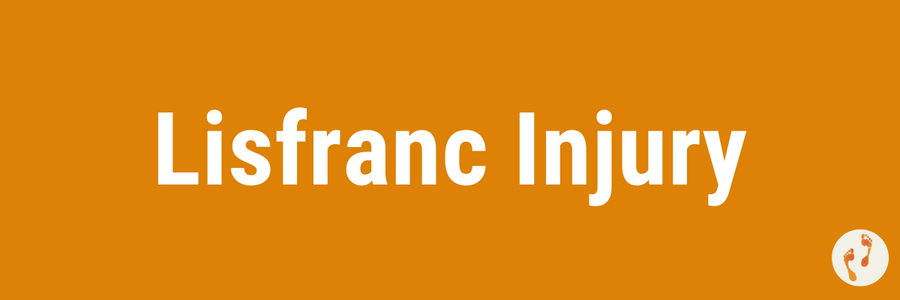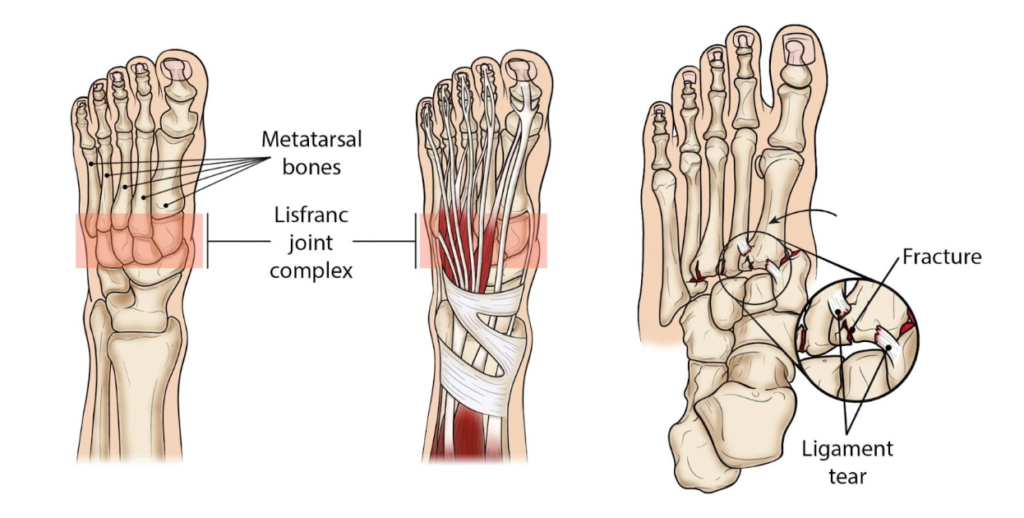 A Lisfranc injury is an injury to the midfoot joint (tarsometatarsal joints), across the Lisfranc joint complex. If you’re looking down at your foot, you will feel the bony bumps that are part of the Lisfranc joint in front of your ankle joint, at the top of your foot, as pictured below.
A Lisfranc injury is an injury to the midfoot joint (tarsometatarsal joints), across the Lisfranc joint complex. If you’re looking down at your foot, you will feel the bony bumps that are part of the Lisfranc joint in front of your ankle joint, at the top of your foot, as pictured below.

The Lisfranc joint plays an important role in helping to hold the height and shape of your arch, and so when the Lisfranc joint is injured, there are many joints, bones and ligaments that may be involved. When a twisting motion with a downwards or upwards movement is applied to this area from a stumble or a fall, it can fracture or dislocate these bones and may sprain or tear the ligaments holding this joint together. This makes it a very serious injury due to the vital role the midfoot plays any time you’re standing or walking. There are three common Lisfranc injuries, which often occur at the same time:
- Sprains or a rupture of a ligament, which result in the midfoot feeling unstable
- Lisfranc fractures which can be an avulsion fracture, where a small piece of bone is “pulled off” or broken.
- Dislocations, when the bones are forced out of their normal position.
Lisfranc injuries are caused by a traumatic accident or event, including in sports such as soccer, rugby, wakeboarding, or snowboarding; they often involve a simple twist and fall as you stumble over your foot, or direct trauma from a big fall or a heavy object dropped on your foot.
Symptoms can be mistaken for a minor sprain of the foot, but this injury is much more painful and can not be walked on. Common signs and symptoms connected to the injury include:
- Pain in your foot, particularly the midfoot. This may worsen when standing, walking or exercising.
- Inability or marked difficulty in weight bearing.
- Swelling on top of the foot that often spreads to toes and bottom of your foot.
- Bruising may occur on the top and bottom of the foot in the arch area, however bruising does not always occur.
- Numbness and tingling of the midfoot and toes
- Abnormal widening of the midfoot
Can You Fix It?
A Lisfranc injury can be treated, but the key to ensuring you recover effectively and as quickly as possible is an early diagnosis. As this injury can be difficult to diagnose, it’s important to work with a trusted podiatrist so they can get you started on an effective treatment pathway.
A Lisfranc injury is diagnosed by taking into account your signs and symptoms, the history of the injury, and by performing a physical assessment. If we suspect a Lisfranc injury, we may refer for an X-ray, CT imaging and MRI, if required, to confirm the diagnosis, the extent of the injury, and which specific structures have been damaged.
How Is A Lisfranc Injury Treated?
Due to the location of the injury, many treatment approaches require periods of time spent in a moon boot, followed by a rehabilitation program that may include:
- Foot mobilisation therapy (see how foot mobilisation can help a painful midfoot injury)
- Custom foot orthotics
- Ensuring you’re wearing the right footwear and that it’s supporting your recovery, and not hindering it
- Padding or strapping as needed
- A stretching and strengthening program to restore strength and function as you progress through your rehabilitation
- Tailored advice from our podiatrists to help you get the most out of your recovery at home
For pain relief of your symptoms, we may also recommend non-steroidal anti-inflammatory medication (NSAIDs) and the RICE protocol — rest, ice, compression & elevation. In some cases, more severe Lisfranc injuries may require surgical management to assist healing.
FAQs
How long does it take to recover from a Lisfranc injury?
While this varies greatly from person to person, generally it can take months or even up to a year for a complete recovery.
Can a Lisfranc injury cause long-term complications?
Yes, you may experience long-term instability and pain when a Lisfranc injury is not treated and continues to be overloaded.
Are there any exercises or physical therapy that can help with a Lisfranc injury?
Absolutely, and your podiatrist will discuss all of this with you during your appointment. You’ll likely be given a custom stretching and strengthening program, will undertake foot mobilisation therapy, and more. The goals of physical therapy are to restore strength, flexibility, and range of motion to the foot and ankle, improve balance and coordination, and promote a safe return to normal activities.
Can a Lisfranc injury be prevented?
It is not always possible to prevent a Lisfranc injury. However, you can reduce your injury risk by:
- Wearing shoes that fit properly and provide adequate support and protection for the feet.
- Using proper form and technique during exercise
- Strengthening exercises can help to improve stability and reduce the risk of injury.
- When starting a new activity or increasing the intensity of an activity, do so gradually to allow the body to adapt and reduce the risk of injury.
- Seeking prompt medical attention for foot and ankle injuries. This is as delayed treatment can lead to further damage and complications.
